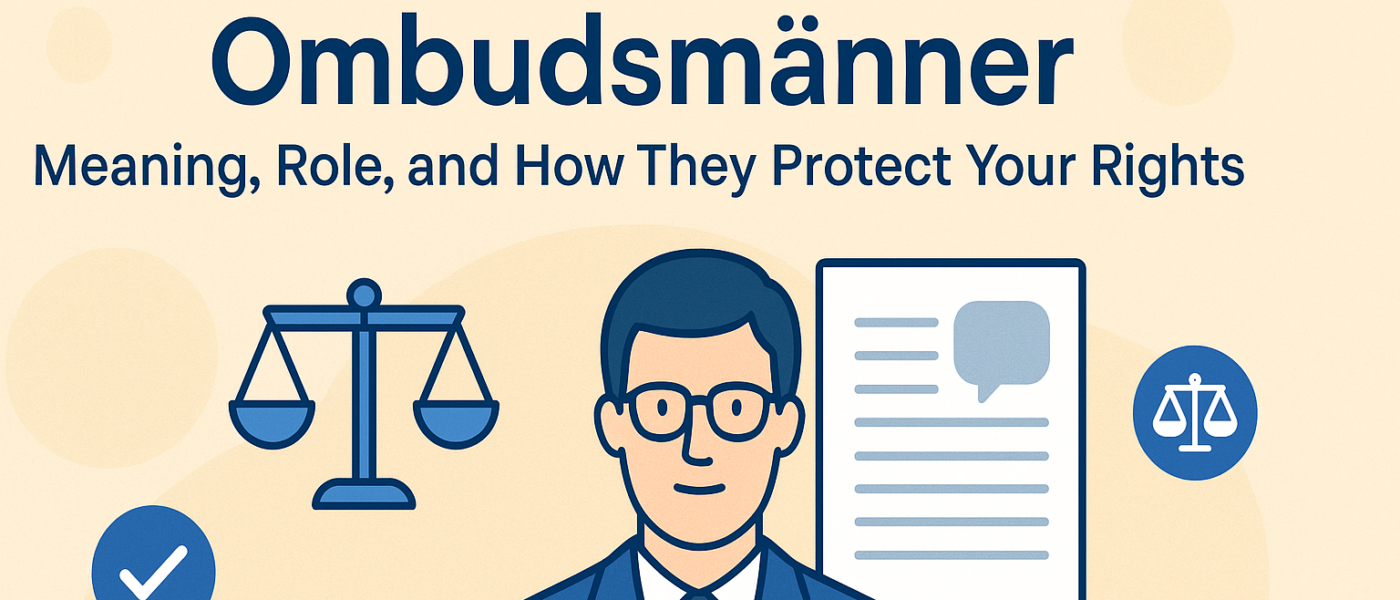Ombudsmänner: Meaning, Role & How They Protect Your Rights
A practical, expert‑backed guide to understanding ombudsmänner—what they do, how to contact them, and how to get results without getting lost in bureaucracy.
What “Ombudsmänner” Means
The term ombudsmänner is the German plural of Ombudsmann—an independent and impartial problem‑solver who investigates concerns and helps people navigate institutions. In English, you’ll see ombudsman or the gender‑neutral ombudsperson/ombuds. In German, neutral plurals such as Ombudsleute are also common. In plain terms: if you feel stuck—by a bank, a university, a government office, an insurer, or even your employer—an ombudsmann can listen confidentially, clarify options, and help resolve the issue informally and efficiently.Core Principles That Guide Ombudsmänner
Across reputable offices worldwide, four pillars define professional practice (as recognized by leading associations):- Independence: Operates separately from line management to avoid conflicts of interest.
- Impartiality: Treats all parties fairly and does not advocate outcomes for one side over another.
- Confidentiality: Conversations are off‑the‑record, with narrow exceptions (e.g., imminent risk of serious harm).
- Informality: Provides options and facilitates solutions without replacing formal grievance or legal channels.
Types of Ombudsmänner (With Real‑World Examples)
Not every ombuds office looks the same. Understanding the variety helps you choose the right channel:- Classical/Public Ombudsmänner: Address complaints about public administration (e.g., a city, ministry, or agency).
- Organizational Ombuds: Internal, confidential resource for employees, students, or members (e.g., corporations, universities, NGOs).
- Advocate Ombuds: Focus on a defined group (e.g., patients, children, long‑term care residents, consumers).
- Sector‑Specific Ombuds: Dedicated to industries with frequent consumer disputes (e.g., financial services, telecom, energy, transport).
When to Use an Ombudsmann
- You’ve tried front‑line customer service or HR and feel unheard.
- You need a confidential sounding board before filing a formal grievance.
- You want options that avoid the cost and complexity of litigation.
- You suspect a systemic issue (policy gaps, fairness concerns, retaliation risk).
How the Complaint Process Works (Step‑by‑Step)
- Intake: You share your concern confidentially (call, email, office hours, or web form).
- Jurisdiction Check: The ombuds confirms the office is the right place and clarifies what they can and cannot do.
- Clarification & Framing: You and the ombuds distill the problem, goals, and boundaries.
- Options Exploration: Coaching for a direct conversation, informal shuttle diplomacy, facilitated meeting, or referral.
- Resolution & Follow‑Up: The office helps test solutions and may suggest systemic fixes to leadership.
Ombudsmänner vs. HR vs. Legal Counsel vs. Regulators
| Channel | Independent | Binding Power | Confidential | Typical Cost to You | Best Use Case |
|---|---|---|---|---|---|
| Ombudsmänner | Yes (by design) | Usually No | Yes (with narrow exceptions) | Free | Early, informal resolution; systemic feedback |
| HR | No (part of management) | No | Limited | Free | Policy guidance; formal internal processes |
| Legal Counsel | Yes (independent) | Through courts | Yes | High | Rights enforcement; litigation strategy |
| Regulators | Yes (statutory) | Often Yes | Varies | Free | Compliance violations; industry standards |
Documentation & Communication Tips
- Timeline first: Note dates, names, decisions, and outcomes.
- Attach evidence: Emails, letters, screenshots, contracts, policy excerpts.
- State your goal: “I want a fee reversed,” “I want a fair re‑evaluation,” or “I want a safe working environment.”
- Keep it neutral: Focus on facts and impact; avoid speculation or accusations.
- Ask for process clarity: “What happens next?” “What are typical timelines?”
Global Context (Germany, EU, USA)
Germany: Sectoral ombuds offices—particularly in finance—offer consumer mediation that’s free and widely used. Many industries publish annual statistics and case themes to drive systemic improvements. European Union: The European Ombudsman investigates complaints about maladministration in EU institutions, ranging from transparency and access to documents to sound financial management and ethics. United States: Numerous federal and state bodies host ombuds programs; many universities and corporations run organizational ombuds offices that adhere to recognized professional standards. Bottom line: wherever you live, you’ll likely find a relevant ombudsmänner office—public, organizational, or sector‑specific—equipped to help.FAQs
Are the decisions of ombudsmänner legally binding?
Usually not. Their influence comes from independence, credibility, and the quality of recommendations—factors that encourage voluntary compliance.Does it cost anything to contact an ombuds office?
No. Consumer and public ombuds services are typically free to the complainant.Can ombudsmänner represent me in court?
No. They’re not a substitute for legal counsel. They provide confidential guidance and informal options.Will the office keep my name private?
Yes, with narrow exceptions (e.g., risk of serious harm). Ask about confidentiality before sharing sensitive details.Sources & Standards
- International Ombuds Association (IOA) — Standards of Practice & Code of Ethics
- United States Ombudsman Association (USOA)
- European Ombudsman — Annual reports & case summaries
